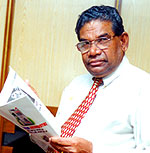The future is mutual
12 Oct 2004
A
P Kurian, chairman, AMFI, and former executive trustee,
UTI, looks at the Indian mutual funds sector
 Mutual
funds are the fastest growing segment of the financial
services sector in India. During the last year, the
assets managed by the industry have grown from Rs87,000
crore to Rs 1.55 lakh crore.
Mutual
funds are the fastest growing segment of the financial
services sector in India. During the last year, the
assets managed by the industry have grown from Rs87,000
crore to Rs 1.55 lakh crore.
The Rs87,000 figure itself is significant, since in the previous year the Unit Trust of India was split into two and Rs30,000 crore went out of the mutual funds industry along with the government-administered UTI-1.
I personally visualise a minimum annual growth of between 30 and 35 per cent, since we are on a growth phase (a real take off, if I may venture to say) as penetration into semi-urban and rural areas is steadily increasing since more and more households are opting for mutual funds.
 The
mutual fund industry in India started in 1964, thanks
to the vision of the then finance minister, the late
T T Krishnamachari (TTK) who wanted to create an institution
that would channelise the funds of small investors into
the capital market. The government engaged David Silver,
known as the father of mutual funds, as one of the consultants,
to create a mechanism and devise an instrument for these
investors.
The
mutual fund industry in India started in 1964, thanks
to the vision of the then finance minister, the late
T T Krishnamachari (TTK) who wanted to create an institution
that would channelise the funds of small investors into
the capital market. The government engaged David Silver,
known as the father of mutual funds, as one of the consultants,
to create a mechanism and devise an instrument for these
investors.
As envisaged 40 years ago, UTI evolved as a government promoted organisation, which combined in itself the functions of a mutual fund and a financial institution. As a result, UTI was allowed to participate in term financing, which today's mutual funds do not do. Its activities as a financial institution were in keeping with the ethos of the times, which required us to promote industries and also promote the capital markets. By 1987, UTI was managing assets worth Rs 40,000 crore. That was the first phase of the mutual fund sector in India.
The second phase of the sector's growth came in 1987 with the entry of government-owned banks and financial institutions like the Life Insurance Corporation, the General Insurance Corporation, the State Bank of India, Canara Bank, Punjab National Bank and others being permitted to set up their own mutual funds. With their entry, mutual funds started penetrating the semi-urban and rural areas and by 1993, the mutual fund market had grown to about Rs80,000 crore.
Then in 1993, came the liberalisation policy, under which, mutual funds were one of the early sectors to be opened to private and foreign participation. As a result, most of the leading foreign funds have set up their operations in the country. This phase has brought many advantages such as high benchmarks in quality and customer service, which are comparable to the best in the world. Consequently, the sector has grown rapidly and is today worth Rs1.4 lakh crore
Systems
and safeguards
Keeping pace with the growth, a stringent regulatory
framework has evolved. It started with the promulgation
of the Mutual Fund Regulation Act 1993, amended in 1996,
which lays down the regulatory framework and extensive
operational details for the functioning of these funds.
Here, the Association of Mutual Funds of India (AMFI), helped create regulatory and disclosure norms that could match with the best in the world. We have evolved standards and practices of professional and ethical conduct in every area starting from the wording of offer documents, disclosures, transparency, and valuations — the heart of mutual funds — to training intermediaries who are the sellers of mutual funds, and a code of conduct within which to operate.
And, I must say very humbly, thanks to the people around AMFI, all these steps have contributed to the enormous acceptance of the wide variety of innovative products tailored by mutual fund houses to suit the varied needs of the entire investment community — for children, couples, parents or the aged and the retired.
In fact, we now have, perhaps, the world's best array of products ranging from conventional products like growth and income schemes to sophisticated products like index funds, sector specific products and what is called new generation products like exchange traded funds which are funds traded on the exchanges. Right now, an AMFI committee is exploring the possibility of funds to invest in commodity futures and capital guaranteed products.
However, in an industry where lakhs of applications are processed, there can always be a slip up, a mistake or an error. Some time ago, the newspapers had reported the switching of shares by a mutual fund. Subsequent investigations revealed the switch was caused by a transaction error.
When lakhs of applications are processed at various levels — the branch, the registrar's office or the front office — an entry may some times be wrongly entered or missed out altogether. However, what was encouraging was that it was detected purely through the internal control system of the fund and rectified immediately.
Since internal controls and monitoring exist at three levels — the directors of the asset management company, the trustees of the funds who have fiduciary responsibility and SEBI to whom daily, weekly, fortnightly, monthly, quarterly and annual reports are provided, the scope for wilful misconduct becomes extremely difficult. That is why the error was detected within a matter of days and remedial action was initiated instead of being swept under the carpet.
Investor
protection
Investor protection needs to be understood in its totality,
since there are different dimensions to it. What is
protection? Can a body protect you? Or does it help
you to protect yourself? Protection has to be differentiated
from guarantees and assurances. To my mind protection
can be ensured through policies, systems, practices
and procedures being followed meticulously so that the
interest of the investor is protected.
What is the investor's interest? That his money is handled responsibly, and the capital is protected through proper controls; investments guidelines and; the investor's right to know where his money is being invested and how it is being used. The funds have to disclose periodically how they invest the funds.
These stipulations create built-in protection, and by and large, we have noticed that individual fund managers act responsibly and within the specified standards. Since laws set the limits, the mutual fund industry tends to practice a more transparent, open book approach.
Another form of protection is ensuring easy encashability, if the investor wishes to withdraw from a fund. Investors want their returns to be protected. But mutual funds are not permitted to offer guaranteed returns like a fixed deposit. Last year most, if not all, diversified equity funds have given 100 per cent returns without having guaranteed such returns. This is an excellent way of protecting the investor interest.
And, finally, the investor is required to be protected from procedural or systemic failures or breakdown — such as when an investor moves residence, and the new address is not recorded with the fund. This is where benchmarks and best practices play an important role plus, of course, the competitive pressure among the 29 mutual fund companies to provide highest service standards.
At AMFI, our role is to set the standards in valuations, accounting, construction of NAVs, disclosures and guidelines for investment and limits to exposure in individual companies. The financial services sector functions on the basis of trust and confidence, and, confidence is best established through transparency, responsibility and ethical conduct, without exaggerated promises of appreciation or return.
I feel that the sector has a very interesting past, an encouraging present and a very bight future.
(The
author was formerly executive trustee of Unit Trust
of India and is currently the chairman of the Association
of Mutual Funds of India.)






























